Why farmers like the Orange Summer pumpkin so much: a hybrid, easy to care for and indispensable in cooking
Pumpkin is a tasty and healthy vegetable containing beta-carotene, B vitamins and other beneficial substances. It has low allergenicity and calorie content. Suitable for adults and children.
Of all the varieties, gardeners prefer fruits with good taste and universal use. The Orange Summer pumpkin meets these requirements. The hybrid pleases not only with its commercial characteristics, but also with its high immunity to diseases.
Description of the hybrid
Pumpkin Orange Summer f1 is a first generation hybrid, making seeds from the fruit unsuitable for cultivation. The original name is Orange Summer, which translated from English means “Orange Summer”. The hybrid received this name because of the color of the fruit.
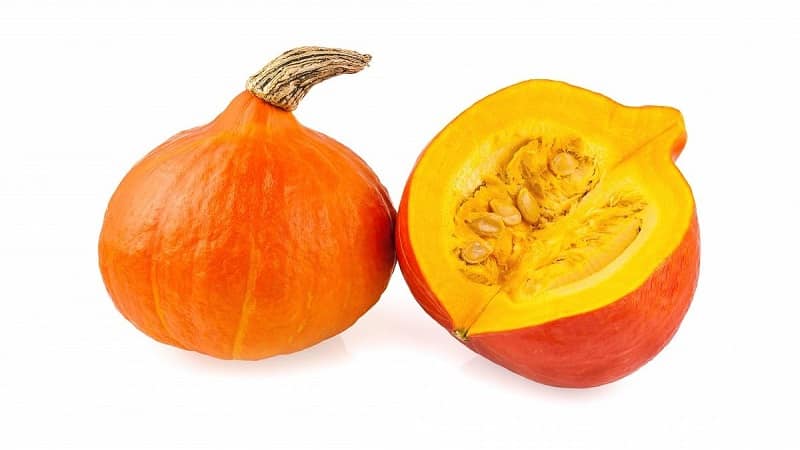
Peculiarities
Orange Summer distinguished by beautiful small fruits. The weight of each of them is 1–1.5 kg. Most gardeners like pumpkins because of their portion size.
The berry pulp is juicy and crispy. The taste is sweet with a pronounced pumpkin aroma. The shape of the fruit is normal, round.
Main characteristics
Orange Summer will delight both experienced and novice gardeners. The vegetable has high immunity to melon and melon diseases. This reduces the need to treat it with chemicals.
The characteristics and description of the hybrid are presented in the table:
| Options | Indicators |
| Type of ground part | The stems are powerful, creeping and climbing. The length of 1 lash reaches 1 m. Light ribbing is observed on the stems.The peduncle is strong, cylindrical in shape. The leaves are large and dark green. The root system is powerful. The main root goes deep underground, and the lateral roots grow along the surface. |
| Fruit | Small size (portioned). The weight of one pumpkin reaches 1–1.5 kg. The peel is dense, but not thick. The color is dark orange with light (white) stripes. Inside the flesh is bright orange. The tip has a dark gray spot with a white dot in the center. Not many seeds. The shape of the fruit is round, flattened at the tip, with an elongated tail at the base. There is a faint ribbing throughout the entire area. The pulp is juicy and crispy, sweetish. Pronounced pumpkin aroma. |
| Ripening time | Early maturing crop. From sowing the seeds to the ripening of the fruits, 90–100 days pass. |
| Transportability | High. Pumpkin tolerates transportation well. Can be stored for more than 4 months. |
| Productivity | Average. From one plant you get from 2 to 4 fruits. |
| Immunity | It has high immunity to most diseases of melons and melons. |
Features of cultivation
Well-lit areas of the garden are suitable for pumpkins.. Other melon crops should not grow on them the year before. In the beds after legumes, nightshades and root vegetables, this vegetable feels best.
Pumpkins need fertile, loose soil. Her being prepared in the fall, digging, clearing weeds and fertilizing. The soil is mixed with cow manure: 8 kg of fertilizers are taken per 1 m².
If soil acidity levels are not suitable for pumpkin, this can be corrected in the following ways:
- Acidic soil: soil is mixed with ash or dry lime.
- Heavy soil: river sand is added to the top layer of soil.
- Poor soils: Pumpkins are planted near a manure pile.
There is no need to dig up the soil in spring. It is enough to level it with a rake and clear it of weeds. The beds are watered with a solution of copper sulfate. It is useful to add 15 g of potassium chloride and superphosphate per square meter.
Note! If you plant a crop on poor soil, it will not die, but the fruits will be small and tasteless.
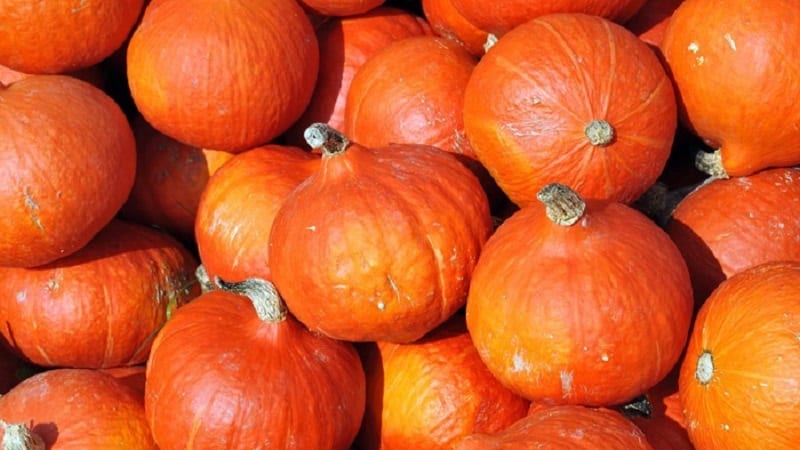
Agricultural technology of Orange Summer pumpkins
Pumpkin is grown both by seedlings (in the southern regions) and by seed (in cities with temperate and cold climates) methods. In the first case, the crop ripens faster, and in the second, the plants grow more resilient.
About other varieties of pumpkin:
Giant variety of pumpkin "Hundred Pound"
 Before planting, the seeds are sorted. Only dense specimens without damage are left.
Before planting, the seeds are sorted. Only dense specimens without damage are left.
Old pumpkin seeds germinate best. They are aged artificially in one of the following ways:
- Wrapped in a piece of linen cloth. Then they are placed to warm up in the sun or a radiator.
- Place in an oven preheated to 20°C. Every hour the temperature is increased by 10 °C. The planting material is heated in this way for 5 hours.
- Soak in water at a temperature of +40…+50 °C for 3 hours. It is important that the liquid does not cool down.
After aging, the seeds are soaked for 20 minutes. in a light pink solution of potassium permanganate, then washed under running water.
To speed up the appearance of the first shoots, the grains are sprouted: wrapped in damp gauze and left in a saucer covered with film until the seeds open. Warm water is added to the saucer to prevent the fabric from drying out.
When the seeds hatch, they placed in the refrigerator for 2 days to increase stability to the cold.
Seedling method
Pumpkin seedlings begin to be grown in the second half of April. After 20–22 days, the culture is transplanted into open ground.
Sowing is not carried out in a common box, because... pumpkin does not tolerate pickling. Instead, they use individual pots or peat containers, from which the plants do not need to be removed when replanting.
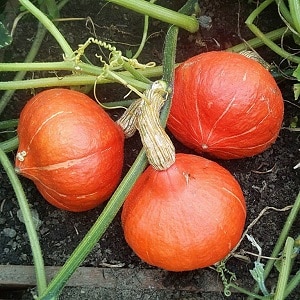 The soil for pumpkin is chosen to be nutritious and loose. A universal mixture for seedlings is suitable. Prepare the soil yourself by mixing 1 part sand and peat. Add 1 tbsp to a bucket of mixture. ash and 1 matchbox of superphosphate.
The soil for pumpkin is chosen to be nutritious and loose. A universal mixture for seedlings is suitable. Prepare the soil yourself by mixing 1 part sand and peat. Add 1 tbsp to a bucket of mixture. ash and 1 matchbox of superphosphate.
Before use the soil mixture is disinfected in one of the following ways:
- calcined in the oven;
- pour over with a dark pink solution of potassium permanganate;
- pour boiling water over;
- pour hot copper sulfate over it.
Non-peat pots are also disinfected, soaking for half an hour in a dark pink solution of potassium permanganate.
Advice! It is convenient to use peat tablets for pumpkin, first soaking them in boiling water until they swell.
They grow seedlings like this:
- 3 cm of sand is poured into the container. The rest of the volume is filled with soil, which is watered abundantly with warm water.
- 2 seeds are planted in each pot, buried 4 cm.
- Before the seeds germinate, the pots are covered with film. When the first shoots appear, it is removed.
- The sprouted seedlings are placed on the windowsill. If there is not enough light, fluorescent lamps are used.
- Water the pumpkin as the soil dries with warm water.
- After true leaves appear on the plants, the weaker stem is pinched.
- 2 weeks after germination, the seedlings are fertilized with Nitrophoska.
- 10 days before planting in a permanent place, the seedlings begin to be hardened by taking them outside every day and gradually increasing the hardening time.
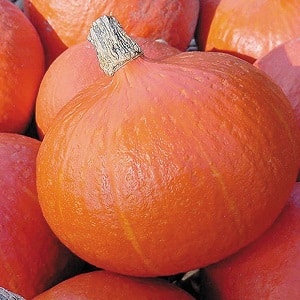 To get strong and healthy seedlings, it is important to observe the temperature regime. Use the following scheme:
To get strong and healthy seedlings, it is important to observe the temperature regime. Use the following scheme:
- before the seeds germinate - +25...+30 °C;
- the first 7 days after the appearance of the first shoots - +15...+25 °C;
- another week - +15...+18 °C;
- the rest of the time - at room temperature.
Plants are planted in a permanent place when 3 true leaves will appear on them. The bushes are placed in holes located at a distance of 1 m from each other. Before this, ash is poured into the recesses and 2 liters of water are poured.
Seeds
In cities with warm climates, the crop is often grown by seed.. Planting material is planted only after the soil at a depth of 15 cm has warmed up to +15 °C (in the second half of May).
Note! With this growing method, the fruits will ripen later.
Pumpkin holes are dug at a distance of 1 m from each other.. The depth of the holes is 6–10 cm. Gardeners advise making holes of different depths - this way the seeds will germinate in any weather conditions. The width of the depressions is 25–30 cm. 2 seeds are planted in each. Planting material is placed at different edges of the hole. The grains are covered with soil on top, without compacting, and watered with warm water.
Crops are covered with film. It is opened slightly for ventilation in the warm season and removed after the formation of true leaves.
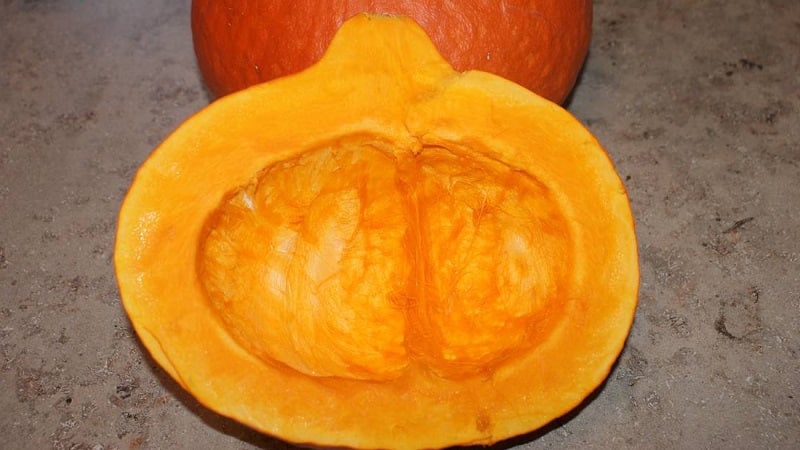
Care
Pumpkin is an unpretentious plant. Despite this, you need to regularly and properly care for it:
- Vegetables are regularly and abundantly watered. For one plant, use at least 3 liters of liquid at room temperature. It is important not to let the soil dry out, otherwise the plant will die.
- After each watering The soil is loosened to a depth of 8 cm and the beds are cleared of weeds.
- After the 3rd leaf appears the weaker plant is pinched.It is not pulled out, but the stem is broken off so as not to damage the roots of the strong one.
- The lashes should not be too long. At level 6 of the sheet they are broken off.
- After the length of the lashes will reach 1 meter, they are pressed to the ground in 1 or 2 places to form new roots.
- The whips are tied up to the trellises or launched along a cord attached to the roof or fence.
- Pumpkin is fed after the formation of 5 leaves every 2 weeks. Alternate mullein and complex mineral fertilizers.
Diseases and pests
Pumpkin Orange Summer has high immunity to diseases of melons and melons. However, it is better to follow preventive measures:
- Disinfect garden tools, as infection may remain on them.
- Plant bushes at sunset or early in the morning. Do not water the crop these days.
- To prevent pests from attacking the pumpkin, spray it with a soap solution (rub 1 piece of laundry soap into a bucket of water) or a decoction of wormwood.
Possible difficulties
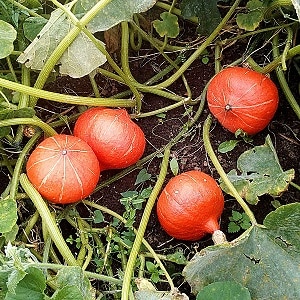 Often when growing crops gardeners face a number of difficulties:
Often when growing crops gardeners face a number of difficulties:
- Seeds take a long time to germinate. This happens if the planting material is buried too deep or planted in heavy soil. Another possible reason is cold ground.
- Plants become stunted after watering. The irrigation water may be too cold.
- Plants are weak and grow slowly. This occurs on poor soils. To solve the problem, cow dung is applied.
- Plant roots begin to rot. The problem lies in weeding too infrequently or uprooting a weaker plant in the hole.
- The pumpkin is withering away and weakens after feeding. To avoid this, the beds must be watered before applying fertilizer.
- Ovaries do not form. Artificial pollination will help. To do this, male flowers are picked and pressed with their stamens to the stigmas of female flowers.
- Pumpkins don't turn yellow with a large number of leaves on the bush. To solve the problem, remove the leaves around the fruit.
- Ugly ovaries form on the bush. To prevent this, no more than 3 fruits are left on one lash.
- The vegetable does not set fruit and produces a large amount of greenery. The reason is too frequent application of fertilizers.
Advice from experienced gardeners
To get a tasty and rich harvest, gardeners use some tricks:
- During flowering plants, increase the frequency of watering. At the same time, make sure that the liquid does not fall on the ground part of the bushes. Otherwise, the pollen will clump together and pollination will not occur.
- Wooden supports are placed under the fruits to reduce the risk of rotting.
- To make the pumpkins more tasty, stop watering during the ripening period.
- If the lashes are directed along a rope tied to a fence or roof, the fruits are secured on them. To do this, they are tied with a net.
Read also:
Harvesting and application
The first harvest is harvested in mid-August. The following signs indicate the ripeness of fruits:
- the stalks become dry and hard;
- the foliage turns yellow and falls off;
- the berries acquire a bright orange color;
- the crust becomes dense and hard.
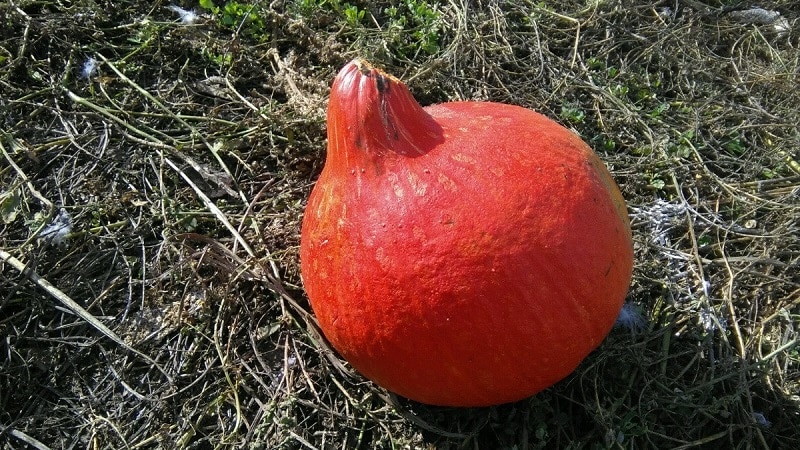
Store vegetables in a cool, dark place. They are suitable for both desserts and hot dishes.
Advice. Use small pumpkins for dishes in which the fruit acts as a pot.
Advantages and disadvantages of a hybrid
Advantages of Orange Summer:
- immunity to diseases of melons;
- ease of cultivation;
- wonderful taste of fruits;
- pumpkin portions.
Considered a disadvantage hybridity of the plant, since its seeds cannot be used for planting.
Farmer reviews
Reviews from vegetable growers about the hybrid Orange Summer is mostly positive. It has a number of advantages with a small number of disadvantages.
Irina, Moscow: “I’ve been growing Orange Summer for several years now. Pumpkin does not require special care. I plant it near a manure pile and don't fertilize it at all. I collect 3 pumpkins from each plant. Very tasty and beautiful fruits, as in the photo".
Elena, St. Petersburg: “I tried to grow Orange Summer for the first time this year. I didn’t encounter any difficulties with agricultural technology. The hybrid was not sick. I liked the fruits. It’s convenient to use because you don’t have to look for space in the refrigerator after cutting a piece.”.
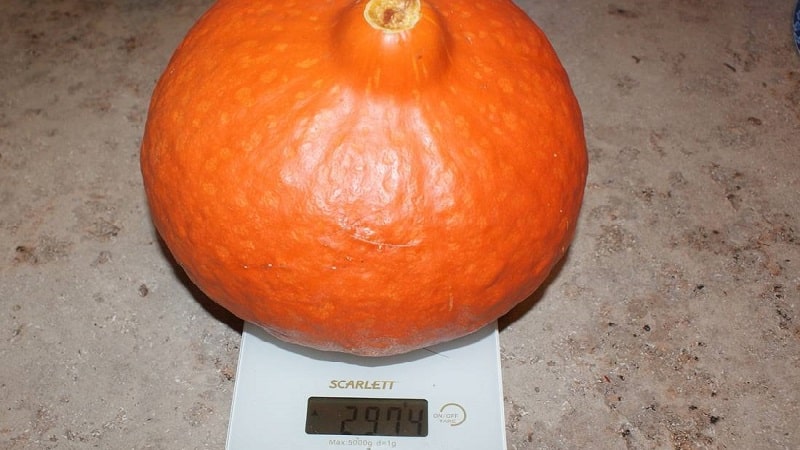
Conclusion
Pumpkin Orange Summer is a hybrid that will delight you with its harvest. The culture produces small but very tasty fruits. They are convenient to use, since each is enough for just one cooking.
Growing a vegetable is not difficult. It is distinguished by its unpretentiousness in care and persistent immunity to diseases of melons and melons.
SUMMER is translated from English as SUMMER, not SUN - accordingly, the name is Orange Summer.
Thank you, Tatyana, you are right. Corrected the title in the text